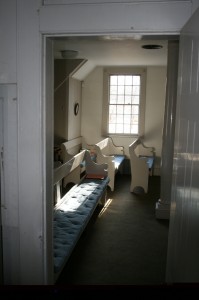
By 1816, Cornwall Meeting had grown so large that it was established as a Quarterly Meeting, of the same organizational stature as Nine Partners (from which it had grown). In 1825 there were 486 members of the Cornwall Monthly Meeting.
About 1827, Quakerism underwent a schism that is sometimes called the “Hicksite Division.” This event occurred at a time when some Quakers grew uneasy with what they felt was a kind of “spiritual inertia” that had set into many Monthly Meetings. Methodism had spread across the United States, stirring religious enthusiasm and effecting Quakers as well as other Protestants. Indeed, in the archives of the Cornwall Monthly Meeting is a handwritten paper that reads:
Friday 10 — I preach’d at the Bull-and-Mouth Meeting which had belong’d near A hundred years to the people called Quakers, as much of real religion as was ever preach’d thare, I trust will be preach’d thare still; and perhaps in A more rationable, scriptural and intelligible manner. John Wesley
Curiously, Wesley’s brief remarks reflect much of the heart of the debate that provoked the Hicksite Division. Quakers disagreed as to the relative primacy, in their Christian testimony, of the historical Christ and the Inward Light of Christ. Strictness of rules and doctrine were subject to challenge, particularly by members of Meetings dominated by strong-willed Elders. Tensions of social and economic class also arose. Faith and Practice, the “Book of Discipline” published by the New York Yearly Meeting , sums it up in these words: “generally orthodox-Christian, elder-supporting, richer, urban Friends and Inward-Light-oriented, elder-questioning, less-well-off, rural ones acrimoniously and resentfully opposed each other.” Proponents of the “Inward Light” found a leader in Long Island farmer Elias Hicks. The disagreement proved intractable, and first the Philadelphia, then the New York Yearly Meetings split into two camps in 1827 and 1828, respectively. These were followed by split Yearly Meetings in Ohio, Indiana and Baltimore.
Cornwall Monthly Meeting was no exception to this phenomenon, and the Meeting was split in 1827. The property of the Meeting, including the Meeting House, the horse shed and the Cemetery, remained with the Hicksite portion of the Meeting. The orthodox families — including the Sands — attempted to keep together as a Meeting, worshipping first at the home of Jabez Green, in Cornwall, and later at a place known as the “Bell House” in Firthcliffe. Thereafter they moved to a brick building adjoining what used to be the Union Hotel in Cornwall. There is some indication, but no certain record, that Orthodox Friends built and worshipped in a structure that was later used as a storage shed located near the Cornwall Yacht Club. (The children of the Cornwall Meeting apparently attended First Day School in that building in the early 1900s.) Eventually, however, Orthodox members moved away or joined other Meetings.
Today, the nearby Clintondale Friends Christian Church follows the Orthodox practice, while Cornwall worships in what might be recognized as the “Hicksite” manner. In August 1958, after a division of 130 years, the Hicksite and Orthodox branches of American Quakerism were officially rejoined, and Cornwall Friends worship regularly with our fellow Friends of Orthodox traditions.
In the mid-1800s the area abounded with Quakers. A local author, Nathaniel Parker Willis, noted in 1855: “Quaker farmers, in easy circumstances — plain but genial folk with well-educated families — are sprinkled thickly over the eastern end of Orange County.” Prominent families in the Cornwall Meeting, such as the Cockses, the Clarks, the Millers and the Townsends, were merchants, tanners or carriage builders. Their economic success meant that Quakers in Cornwall became more and more “easy in circumstances” and not quite so “plain,” and a few changes took place in the Meeting House.
In the 1880s the original four-foot wood shingles on the exterior of the Meeting House were replaced by the present-day clapboards and the two separate entrances were joined by a long porch across the front of the building. The porch featured long steps across the front, for members’ easy “lighting from their carriages.” With the advent of the automobile, the step was later discarded, but the long porch remains.
The interior was painted, and carpet was laid on the floor. The basic unadorned nature of the Meeting House nevertheless remained unchanged; local historian Lewis Beach described the building in 1873 as “painfully plain.”